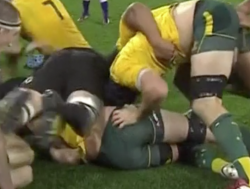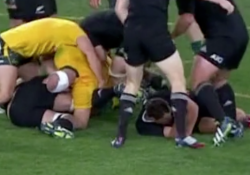After the two recent Bledisloe Cup matches, there was plenty of talk about tactics at the breakdown, yellow cards or lack thereof, and just who should be more outraged by the officiating. After initial viewing, my perception was that Craig Joubert was good, but Jaco Peyper was fairly poor and the Wallabies got the slightly worse deal in the second Test. I felt the Wallabies deservedly lost both Tests.
Suddenly finding myself with plenty of time on my hands, I decided to get to the bottom of this. As a public service to the faithful Green and Gold Rugby readership, I have undertaken a detailed analysis of the All Black and Wallaby work at the breakdown from a defensive point of view.
Yes, I selflessly watched both games again, slowly, painfully and reasonably meticulously to see which team are the greater and lesser offenders. Is it the Sleeping Kiwi, lying all over the wrong side of, well, everything, or is it the Shot Wallaby flopping like roadkill where it should not?
I will preface the findings by stating that I accept that pushing the boundaries is part of the game, and slowing opposition ball happens in all matches. I wanted to see if one team clearly infringes more than the other, and if there were clear differences in how this was officiated.


What I Looked At
I noted every completed tackle contest, not including those ending with a knock-on, player in touch or blown up for a previous penalty, i.e. every time the teams had to contest possession, but not including mauls. I noted whether a defending player ended up where they should not be:
- Sealing off (classic Sleeper or Roadkill).
- Falling out the wrong side and lollygagging around and/or becoming a lazy runner.
- Not releasing the tackler when lying on the ground.
I then noted whether the offending player appeared to slow playing of the ball, and I admit, this is subjective, but I judged it based upon whether the halfback was in position to play the ball but was prevented from doing so, or had his options limited by the player. Meerkat behaviour was excluded (I am looking at you, Will Genia).
I then assessed whether the slowing of the ball or interference was penalised, or had penalty-advantage called, whether it resulted in a turnover to the defending team, and whether the ensuing penalty was in the mythical ‘Red Zone’, which I defined as around or in the defensive team’s 22m zone.
I then ended up with a bunch of numbers, and a new-found level of respect for people that generate statistics for a living, as they must be completely insane.
Show us the numbers, dammit
| All Blacks Defensive Contests | 95 (Syd) | 82 (Wel) | 177 Total |
| Sleeping Kiwi | 27 (28%) | 23 (28%) | 50 (28%) |
| Those that slowed/interfered | 8 (30%) | 11 (48%) | 19 (38%) |
| Penalised | 3 (38%) | 5 (45%) | 8 (42%) |
| Red Zone Penalty | 1 (33%) | 4 (80%) | 5 (63%) |
| Won Turnover | 1 (13%) | 2 (18%) | 3 (16%) |
| Wallaby Defensive Contests | 62 (Syd) | 56 (Wel) | 118 Total |
| Shot Wallaby | 18 (29%) | 21 (38%) | 39 (33%) |
| Those that slowed/interfered | 7 (39%) | 12 (57%) | 19 (49%) |
| Penalised | 1 (14%) | 8 (67%) | 9 (47%) |
| Red Zone Penalty | 0 (0%) | 4 (50%) | 4 (45%) |
| Won Turnover | 1 (14%) | 1 (9%) | 2 (11%) |
What does it all mean?
First, the perception by some that there are more Sleeping Kiwis is correct (50 v. 39), especially in the Sydney Test (27 v. 18). However, this is because the All Blacks had so many more defensive rucks (177 v. 118). Looking at it proportionately, the Wallabies are actually worse offenders (28% v. 33%).
The overall numbers for slowing down the ball (of the sleeping Kiwis, how many worked), or interfering with the play are the same (19 all), but again, the Wallabies have a higher percentage (38% v. 49%). Does this make the Wallabies better at “pushing the boundaries”?
Neither team seemed to profit more in terms of turnovers from slowing the ball, and overall, both infringed approximately the same amount in the red zone in this aspect of play. It was notable that the All Blacks conceded proportionately more penalties in the Red Zone in the second Test.
Finally, while much was made of the lack of a yellow card to Aaron Smith or Kieran Read for the tackle on Christian Leali’ifano, as well as a couple of efforts from Rob Simmons, on my viewing this little sequence below stood out from both games as the worst example of systematic somnolence – where there’s a sleeping Kiwi in almost every breakdown. Notice the times the short side is shielded by a ‘retiring player’. It’s subtle, and very good work if you can get away with it.


